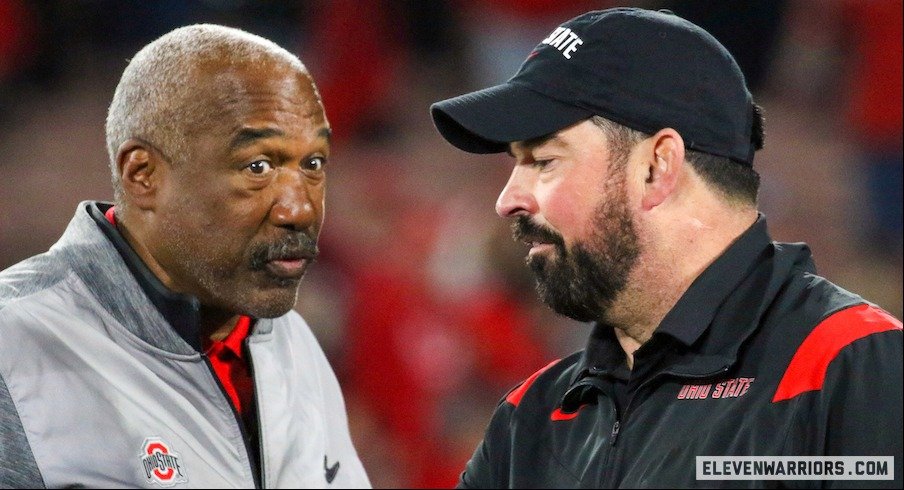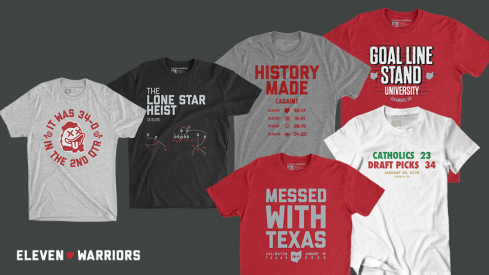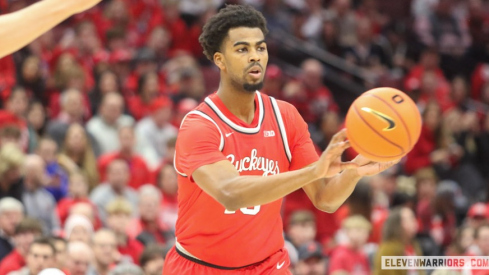Former North Carolina defensive end Beau Atkinson commits to Ohio State.
With a lack of clear-cut rules governing what college sports teams are and are not allowed to do now that athletes are permitted to profit from their name, image and likeness, coaches like Ryan Day are finding themselves in a tough spot.
Do they do whatever they have to do to ensure they continue to land top recruits, even if that means violating NCAA rules that aren’t currently being enforced? Or do they remain careful to follow the law to the letter, knowing that could put them at a disadvantage against schools that are being more aggressive?
Day didn’t try to downplay how tough that conundrum is when he was asked on Friday about the current state of NIL in college sports.
“I think there's risk everywhere,” Day said. “There's risk if you do nothing, you get left behind. If you go the other end, there's risk that you can get fired for cause for crossing the line. So finding that sweet spot is where the challenge is, right? And when there aren’t clear-cut rules or rules that are being enforced, then it creates hard feelings and unrest, and I think that's where we are right now.”
Even though athletes have been allowed to profit from their name, image and likeness since last July, the NCAA still prohibits schools from directly paying athletes and from offering inducements to recruits to attend their universities. The rise of NIL collectives around the country, however, has led to boosters making deals with athletes that their favorite teams are recruiting – both from the high school level and from the transfer portal – to convince them to attend specific schools.
Within the last two months, two collectives have launched in Columbus with the objective of supporting Ohio State athletes.
The Foundation, a collective co-founded by former Ohio State quarterback Cardale Jones and local real estate executive Brian Schottenstein, launched on March 31. Other members of The Foundation’s board include former OSU football coach Urban Meyer, football players J.T. Barrett, Terry McLaurin and Will Allen and basketball star D’Angelo Russell, among others.
Cohesion Foundation, a collective founded by former Ohio State walk-on wide receiver Gary Marcinick, launched on April 12. Cohesion’s board includes former OSU football players Zach Boren, Adam Griffin and Jeff Heuerman and professional golfer Gary Nicklaus, and Griffin and Nicklaus’ more famous fathers – Ohio State legends Archie Griffin and Jack Nicklaus – are also among that collective’s supporters.
Both collectives are operating separately from one another and are not operated by Ohio State, though Cohesion Foundation made a sponsorship deal with Ohio State through Learfield which allows Cohesion to use Ohio State trademarks.
Founders of both of those collectives have said they are focused on making deals with athletes who are already at Ohio State rather than with recruits, though The Foundation has had conversations with both high school prospects and players in the transfer portal – including Ohio State men’s basketball transfer Tanner Holden, who announced a partnership with The Foundation shortly after his commitment to the Buckeyes – about the opportunities that could be available to them once they arrive at Ohio State if they choose to become Buckeyes.
“Just as long as there's no transaction, you can tell them about The Foundation and what we can do, what we've done for other players, but we just officially can't make any sort of transaction to them,” Schottenstein told Eleven Warriors in a recent interview. “I know a lot of the other schools down in the south are not following those rules and they're actually paying recruits. So that's not easy to compete with, but we're gonna do everything above board and make sure that we're following all the NCAA rules.”
Marcinick told Eleven Warriors that Cohesion Foundation plans to “err on the conservative side” until it becomes more clear what NIL collectives actually are and aren’t allowed to do.
“There will be, I think, differentiation amongst different collectives throughout the country. I think some will do it to the letter and some will operate in the gray area. We want to keep this black and white,” Marcinick told Eleven Warriors in April. “We'd rather walk before we jog, before we run. There's too much at stake for everyone involved not to do it as perfectly as we know how.”
Even without making actual deals with recruits, Schottenstein and Marcinick both believe their foundations – which fund NIL deals for athletes by collecting donations from the community and using the money they raise to partner with local charities – can ensure Ohio State remains a top destination for top prospects by increasing the earning potential for Buckeye athletes.
“We're talking to corporations now that are looking to possibly do really large six-figure donations,” Schottenstein said. “So I think having that, combined with the massive fan base across the country, we definitely will continue to be able to compete with other schools.”
Since we launched a few weeks ago, we have received 1000s of emails, inquiries and offerings to help or get involved in the cause to info@thefoundationohio.com We will be answering and responding ASAP! Please continue to contact us at info@thefoundationohio.com Thank you!
— The Foundation (@TheFoundation1_) April 27, 2022
The Foundation has only made deals with Ohio State football and men’s basketball players so far, but Schottenstein said The Foundation wants to expand its reach to additional sports “in the near future.” Cohesion has not yet announced any deals with Ohio State athletes, but Marcinick said his goal is to eventually fund deals for hundreds of athletes across all Ohio State sports.
“We ideally would love to do something for everyone,” Marcinick said. “I hope we get to the point where we can do that. And I have a fairly strong belief we can. Even if it's something small, it's still going to be meaningful to those people.”
Thrilled to support our hard working athletes! Go bucks! #OhioState #ohiostateathletics @OhioStateFB @OhioStAthletics pic.twitter.com/dy3gVs2aZX
— Cohesion Foundation (@cohesionohio) April 16, 2022
Ohio State is glad to have multiple NIL collectives working on its behalf, knowing the Buckeyes would be behind if they did not have any collectives.
“I think it's critical that we have the collectives,” said senior associate athletic director of sport administration and student-athlete development Carey Hoyt, who oversees Ohio State’s NIL administration. “Having two large groups, I think is advantageous, because if you're a 16, 17, 18-year-old recruit, and you have opportunities at Power 5 schools, obviously as you're making your decision, you're going to want to know that the opportunity is going to exist at that school. So if we didn't have any collectives, if we were just stiff-arming that whole concept, I think it would be a huge disadvantage to our teams and coaches.”
That said, Ohio State – who has designated staff members who are not coaches that communicate with the collectives and others who want to make NIL deals with athletes – has discouraged the collectives from offering NIL deals to recruits, even though OSU does not determine what deals the collectives do or not do make.
“While it's technically not against any rule for someone in a collective to interact with a recruit, it's very gray and it's not an area that we're comfortable. We view NIL very much for current student-athletes, and we just try and keep that separation as best we can,” Hoyt told Eleven Warriors in April. “But these are third parties, their own individual entities, and I've had conversations with Cardale and Brian and Gary and all of the people to try and help them understand the risk.
“Ultimately, the NCAA has the ability to come in and look at things should they decide to. Are they going to? That's to be determined. I think it's potentially happening at other schools. And you just open yourself up to that scrutiny when you're kind of throwing that out there. And I just think it's risky.”
While the NCAA has not yet punished anyone for using NIL deals as recruiting inducements, a crackdown on such deals from the NCAA could begin as soon as this week. According to reports from Sports Illustrated’s Ross Dellenger and CBS Sports’ Dennis Dodd this past week, an NCAA working group could release new guidelines governing NIL deals as early as Monday. Dellenger reported the NCAA could even issue retroactive sanctions for deals that have already been made that violate the new guidelines.
How effectively the NCAA will actually be able to enforce those guidelines remains uncertain. The biggest reason why the NCAA didn’t create bylaws to regulate NIL last year was the threat of lawsuits due to varying NIL laws in different states throughout the country. That threat remains very real – which is why Pac-12 commissioner George Kliavkoff and SEC commissioner Greg Sankey went to Capitol Hill this past week to lobby Congress to pass federal NIL legislation – and Ohio State athletic director Gene Smith, who serves on the working group putting together the new guidelines, admitted to Dodd that “we know we're going to get lawsuits” if the NCAA begins restricting NIL deals.
Nevertheless, the NCAA is expected to move forward with new NIL guidelines because it believes it can no longer allow collectives to orchestrate pay-for-play deals without retribution.
“What's happening in that space is what we were all fearful of,” Smith told CBS Sports. “What's going on – on campuses (with existing scholarship athletes) – currently is fine. It's the inducement pieces. We gotta kill that. If we don't kill that now, forget it.”
Several Ohio State football coaches, including wide receivers coach Brian Hartline, share Smith’s concerns about the deals NIL collectives are making with recruits.
“I think the ability to maximize one's NIL is awesome,” Hartline said Friday. “There just needs to be guardrails. And I think NIL was created to have Outback Steakhouse and Bose headphones and people like that to reach out and let you market with young athletes. Not for collectives to go out there and buy players.”
Day also wants to see stricter rules in place – and for those rules to actually be enforced – so he and his staff no longer have to guess about what they’re allowed and what they’re not allowed to do. If that doesn’t happen, however, Day says Ohio State will adjust as needed.
“I think we all do much better when it's black and white. And it's gray (right now),” Day said. “And so I think the easy thing to do is throw up your hands and complain. But we're gonna adapt and figure out a way to make it work for Ohio State.”
Hoyt said Ohio State wants to do everything it can to help its athletes land NIL deals and to help its teams land top recruits, but not at the cost of possible NCAA violations, as she believes the schools that operate within the rules now will be in the best position in the long run.
“You want to be on the edge and doing everything you can to remain competitive. But at the end of the day, I think you have a sense of what's right and wrong,” Hoyt said. “I mean, if you've been in this business for any amount of time, you have that gut check. And I think that that's really important, now more than ever. And I think over time, it's going to even out and I think the people that are maybe crossing the line and diving in a little too deep, I think ultimately, it's gonna have to stop. This environment cannot continue for 5-10 years. There's just no scenario where the model as we know it survives in this environment.”


